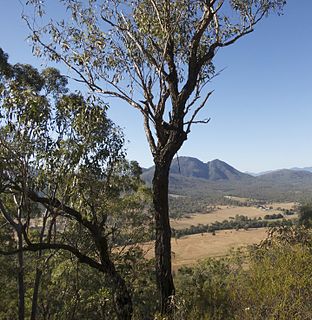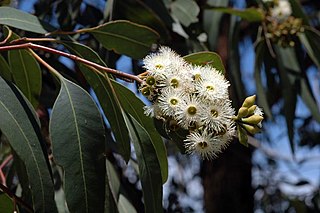
Eucalyptus caleyi, commonly known as Caley's ironbark or Ovenden's ironbark is a species of small to medium-sized tree, endemic to eastern Australia. It has brown or black "ironbark" on the trunk and main branches, dull bluish grey lance-shaped to egg-shaped adult leaves, flower buds in groups of seven, white flowers and barrel-shaped or conical fruit. It grows on the Central and Northern Tablelands of New South Wales and in south-eastern Queensland.

Eucalyptus dura is a species of small to medium sized tree that is endemic to south-eastern Queensland. It has rough, dark grey to black "ironbark", lance-shaped adult leaves, flower buds in groups of seven, white flowers and conical fruit.

Eucalyptus ancophila is a tree endemic to a small area of New South Wales in eastern Australia. It has grey "ironbark", glossy green, lance-shaped leaves, flower buds arranged in a branching inflorescence with seven oval to diamond-shaped buds in each umbel, white flowers and conical or barrel-shaped fruit.
Eucalyptus fracta is a species of tree or mallee that is endemic to a small area of New South Wales. It has hard, grey to black "ironbark" on the trunk and larger branches, smooth whitish bark above, lance-shaped adult leaves, flower buds in groups of seven, and cup-shaped fruit.

Corymbia bloxsomei, commonly known as yellowjack, yellow jacket or yellow bloodwood, is a species of tree that is endemic to inland, south-eastern Queensland. It has thick, rough scaly bark on the trunk and larger branches, lance-shaped or curved adult leaves, flower buds in groups of seven, nine or eleven, creamy white to pale yellow flowers and barrel-shaped, urn-shaped or spherical fruit.
Corymbia clandestina, commonly known as the Drummond Range bloodwood, is a species of small tree that is endemic to Queensland. It has rough, tessellated bark on the trunk and branches, lance-shaped adult leaves, flower buds in groups of seven, white flowers and urn-shaped to barrel-shaped fruit.
Corymbia ellipsoidea is a species of tree that is endemic to Queensland. It has rough bark on the trunk and larger branches, lance-shaped adult leaves, flower buds usually in groups of seven, creamy white flowers and barrel-shaped to urn-shaped fruit.
Corymbia lamprophylla, commonly known as the shiny-leaved bloodwood, is a species of tree that is endemic to central Queensland. It has rough, tessellated bark on the trunk and larger branches, lance-shaped adult leaves, flower buds in groups of seven, creamy white flowers and urn-shaped fruit.
Corymbia leptoloma, commonly known as the yellowjacket or Paluma Range yellowjacket, is a species of tree that is endemic to Queensland. It has rough, tessellated bark on the trunk and branches, lance-shaped or curved adult leaves, flower buds in groups of seven and barrel-shaped, urn-shaped or shortened spherical fruit.
Corymbia petalophylla is a species of tree that is endemic to Queensland. It has rough, tessellated bark on the trunk and branches, lance-shaped or curved adult leaves, flower buds in groups of seven, white flowers and barrel-shaped, urn-shaped or shortened spherical fruit.
Corymbia rhodops, commonly known as the red-throated bloodwood, is a species of tree that is endemic to Queensland. It has rough, tessellated bark on the trunk and larger branches, lance-shaped adult leaves, flower buds in groups of seven, creamy white flowers with a red centre, and urn-shaped to barrel-shaped fruit.
Corymbia stockeri, commonly known as the blotchy bloodwood, is a species of small tree that is endemic to Cape York Peninsula in Queensland. It has rough, tessellated bark on the trunk and branches, lance-shaped adult leaves, flower buds in groups of seven, creamy white flowers and barrel-shaped to urn-shaped fruit.
Eucalyptus atrata, commonly known as the Herberton ironbark or blue-leaved ironbark, is a small tree that is endemic to Queensland. It has hard, black "ironbark" on the trunk and all but the thinnest branches, lance-shaped adult leaves, buds usually arranged in groups of seven, white flowers and cup-shaped to hemispherical fruit. It is characterised by the blue-grey, powdery bloom on its leaves and flower buds.

Eucalyptus beaniana , commonly known as the Bean's ironbark, is a small tree that is endemic to Queensland. It has rough, furrowed "ironbark" on the trunk and branches, dull green to bluish, lance-shaped to curved adult leaves, flower buds in groups of seven, white flowers and cup-shaped to conical fruit. It is only known from four locations in southern inland Queensland.
Eucalyptus melanoleuca, commonly known as yarraman ironbark or nanango ironbark, is a species of tree that is endemic to south-east Queensland. It has rough ironbark on the trunk and larger branches, smooth bark above, lance-shaped adult leaves, flower buds in groups of seven, white flowers and barrel-shaped, to cup-shaped or conical fruit.
Eucalyptus sicilifolia is a species of small ironbark tree that is endemic to Queensland. It has dark ironbark on the trunk and branches, narrow lance-shaped to curved adult leaves, flower buds in groups of seven, white flowers and cup-shaped to barrel-shaped fruit.
Eucalyptus suffulgens is a small to medium-sized tree that is endemic to Queensland. It has hard ironbark on the trunk and larger branches, smooth bark above, lance-shaped adult leaves, flower buds in groups of seven on the ends of branchlets, white flowers and barrel-shaped fruit.

Eucalyptus virens, commonly known as the shiny-leaved ironbark, is a species of small to medium-sized tree that is endemic to Queensland. It has hard ironbark on the trunk and branches, narrow lance-shaped adult leaves, flower buds in groups of seven, white flowers and hemispherical fruit.
Eucalyptus farinosa is a species of small tree that is endemic to Queensland. It has hard, dark grey ironbark, egg-shaped to lance-shaped adult leaves, flower buds in groups of seven, white flowers and cup-shaped to barrel-shaped and ribbed fruit.
Eucalyptus scopulorum is a species of small tree that is endemic to a small area of northern New South Wales. It has rough ironbark on the trunk and branches, lance-shaped adult leaves, flower buds in groups of seven, white flowers and barrel-shaped or conical fruit.






